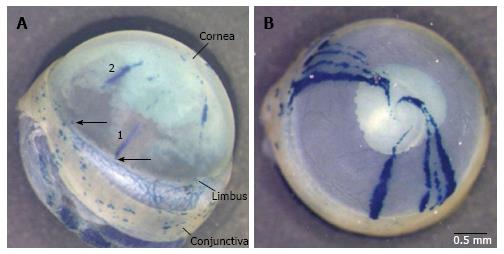Copyright
©The Author(s) 2015.
World J Stem Cells. Mar 26, 2015; 7(2): 281-299
Published online Mar 26, 2015. doi: 10.4252/wjsc.v7.i2.281
Published online Mar 26, 2015. doi: 10.4252/wjsc.v7.i2.281
Figure 6 Preliminary results from a lineage tracing experiment to distinguish between the limbal epithelial stem cell and corneal epithelial stem cell hypotheses.
Eyes from CAGG-CreER; R26R-LacZ mice that were injected with tamoxifen to induce LacZ reporter gene expression and stained for β-galactosidase (β-gal) activity after different chase periods. The pigmented iris is visible through the cornea and appears grey, whereas the β-gal staining is blue. A: Side view of a β-gal-stained eye, after a chase period of 9 wk and 4 d, with several radial β-gal-positive stripes and small patches in the cornea and numerous β-gal-positive patches in the conjunctiva. (The conjunctiva is torn near the limbus and hangs down at the bottom right of the photograph, so the sclera is visible between the limbus and conjunctiva.) Stripe 1 is a limbus-cornea (LC) stripe, with its more peripheral end in the limbus (arrow), consistent with expectations of the limbal epithelial stem cell (LESC) hypothesis (see Figure 5). It also appears to be aligned with other β-gal-positive patches towards the centre of the cornea so it may be part of a longer discontinuous stripe. Stripe 2 is a cornea-cornea stripe with both ends in the cornea, consistent with the corneal epithelial stem cell hypothesis. However, it is radially aligned with a small β-gal-positive patch in the limbus (arrow), which could be the location of a β-gal-positive LESC. If so, stripe 2 might be a discontinuous stripe, which extended from a LESC that was not continuously active (consistent with the LESC hypothesis); B: Anterior (frontal) view of a β-gal-stained eye, after a 14-wk chase period, with eight radial β-gal-positive stripes. All eight stripes are LC stripes with one end at the limbus and many extend the full radius and have a curved end, consistent with a central spiral pattern, as reported for other chimaeric and mosaic eyes[27,72,73]. CAGG-CreER; R26R-LacZ mice were produced by crossing CAGG-CreER and R26R-LacZ mice [full names Tg(CAG-cre/Esr1*)5Amc and B6.129S4-Gt(ROSA)26Sortm1Sor/J; references[116,117]. LacZ reporter gene expression was induced at 12 wk by 3 injections of tamoxifen (100 μg/g body weight per injection).
- Citation: West JD, Dorà NJ, Collinson JM. Evaluating alternative stem cell hypotheses for adult corneal epithelial maintenance. World J Stem Cells 2015; 7(2): 281-299
- URL: https://www.wjgnet.com/1948-0210/full/v7/i2/281.htm
- DOI: https://dx.doi.org/10.4252/wjsc.v7.i2.281









